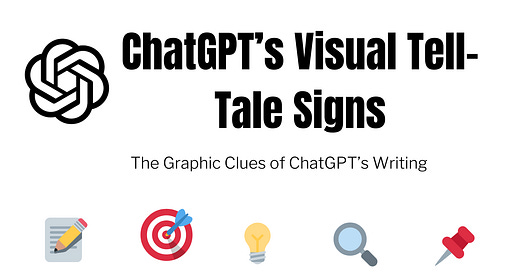ChatGPT'S Visual Tell-Tale Signs
Every time OpenAI rolls out a new update, I check it, test the new features, and come away with the same conclusion: GPT seems to have hit a plateau in its writing style. Whether it's GPT-4, GPT-4o, or now GPT-4.5, the differences are barely noticeable.
The same overused phrases, predictable structures, and preferred lexicon keep showing up almost like a linguistic fingerprint we’ve all learned to recognize.
I suspect the issue lies in the training data. If we want a real breakthrough in writing quality, large language models (LLMs) need access to richer, more diverse datasets.
Imagine if major AI companies (e.g., OpenAI, Google, and Anthropic) struck deals with key academic journals and research libraries to incorporate high-quality scholarly language into their training.
That could push AI-generated writing to a new level!
Sam Altman recently hinted that an upcoming update will significantly improve creative writing. We’ll see. But so far, AI-generated text remains easy to spot.
In previous posts, I’ve talked about the linguistic patterns that give ChatGPT away, certain structures and word choices that make AI-generated text recognizable.
But there’s more to it than just words. ChatGPT has visual tell-tale signs too, like its frequent use of specific icons.
Here’s a list of icons that keep showing up in ChatGPT's responses. Next time you see them in a student’s paper, pause for a closer look, it might just be AI-generated.
📝 : Notepad
💡 : Lightbulb
🎯 : Target
🔍 : Magnifying glass
📌 : Pushpin
📚 : Books
📊 : Bar chart
🛠️ : Tools
🚀 : Rocket
🔗 : Link
✅ : Checkmark
❌ : Cross mark.
💬 : Speech bubble
⚠️ : Warning
🎓 : Graduation cap
⏳ : Hourglass
🤖 : Robot
Final thoughts
This isn’t a formal study—just insights from my extensive experience with ChatGPT. As an AI researcher and tool reviewer, I interact with these systems daily and can often spot AI-generated text in seconds. It’s everywhere online.
Teachers, use these linguistic and visual cues to make informed decisions about AI use in student work. And if you rely on AI detection software, cross-check its results before jumping to conclusions.
AI isn’t the problem—how it’s used is!




